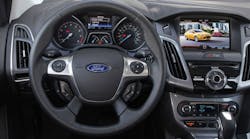Imagine a day when you're driving in a patch of heavy traffic, and your car -- sensing your elevated stress level -- automatically blocks all incoming cell-phone calls until the congestion dissipates.
Ford Motor Co. does.
The automaker sees the ever-increasing number of sensors, cameras and data-capture technologies in cars and trucks as the foundation for a future in which intelligent vehicles take an active role in preventing traffic accidents.
"Vehicle-control inputs, sensors, road conditions and biometric information such as a driver's pulse and breathing can all be used to create a driver-workload estimation that can then help manage certain functions in demanding situations," says Jeff Greenberg, senior technical leader of Ford Research and Innovation.
That includes "intelligently managing incoming communications" by analyzing data from driver-assist systems such as blind-spot radar sensors and lane-keeping cameras -- both of which are available on the 2013 Ford Fusion -- to determine the level of external demand on a driver at any given time, Ford says.
The data -- along with input from the driver's use of the throttle, brakes and steering wheel -- is plugged into an algorithm that produces a "driver-workload estimator," which could block incoming phone calls if the workload is high.
For example, a vehicle's side-looking blind-spot radar sensors and forward-looking lane-keeping camera could indicate that the lane into which a driver is merging contains heavy traffic.
Combined with the vehicle's awareness of the fact that the driver has increased the throttle-pedal pressure to speed up, the vehicle could determine that the driver workload is too high for incoming phone calls.
Monitoring Driver Health
In the future, Ford hopes to feed even more data into the driver-workload algorithm.
The automaker is developing a biometric seat, seat belt and steering wheel that can monitor the driver's condition and, consequently, create a more precise picture of the workload on the driver.
Ford's researchers have built a biometric seating buck to test a number of different sensors and gather data on how drivers respond to a variety of inputs for a driver-behavior model.
The experimental system adds several sensors to the steering-wheel rim and spokes to get more detailed driver information.
Ford notes that the technology is similar to the heart-rate sensors found on treadmills and other exercise equipment today.
"While these features are still in research, they show significant opportunity for us to leverage data already being captured by the vehicle and apply an intelligent decision-making system to simplify the driving experience," says Gary Strumolo, manager of vehicle design and infotronics, Ford Research and Innovation.
Ford also is working on a traffic-jam assist feature, which would use existing radar and camera technology to help a vehicle keep pace with other vehicles in traffic and provide automated steering control to help the driver stay in the current lane.
The system "has the potential to follow the traffic ahead while maintaining lane position in environments where there are no pedestrians, cyclists or animals, and where lanes are clearly marked," according to Ford.
Ford says the intelligent driving technology could reduce driver stress and help minimize gridlock.
Caption
Data from existing driver-assist technologies -- such as the Ford Fusion's lane-keeping camera and pull-drift sensor -- can be plugged into an algorithm that produces a "driver-workload estimator," which Ford hopes will enable future vehicles to take a more active role in preventing accidents.




